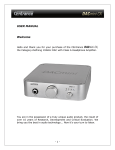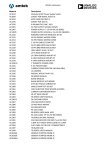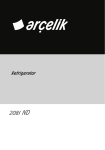Download DACmini CX - CEntrance
Transcript
DACmini CX A Decade of Design Practice Case Study CEntrance, Inc. Chicago, USA -1- Introduction The CEntrance DACmini is a groundbreaking tool for audiophile listening. Its sophisticated design combines the latest innovations in D/A Conversion and Headphone Amplification technology with an innovative, custom extruded aluminum enclosure, designed to keep your audio protected from external interference. CEntrance’s extreme focus on design quality coupled with our unique experience gained over 10 years of designing equipment for largest audio brands gives DACmini a clear advantage over standard D/A converters. We wrote this paper to outline the main category-defining features, which make DACmini unmistakably differentiated by design. Technology Innovation Background CEntrance got its start in the broadcast industry. Our customers include journalists and field reporters, who travel the world with their recording equipment – they can’t afford to have it fail in the field or be incompatible with local conditions. As they say, “The show must go on” and our customers demand the best sounding, rugged, wellbuilt audio products. CEntrance develops all equipment to these highest standards of quality and reliability. That’s how we designed the DACmini. Not only is it built like a tank, it also sounds great. Top Ten Design Features DACmini’s Top Ten design features are as follows: 1. 2. 3. 4. 5. 6. 7. 8. 9. 10. Audio signal path with relay muting and full galvanic isolation Digital signal path with proprietary JitterGuard™ technology Split-ground design, transformer-isolated custom power supply Tongue-and-groove, RF-blocking custom aluminum enclosure Shielded cavity for the digital source selection circuitry Smart source selector and power switch Heavyweight, grounded aluminum volume knob Drop-protection pot guard rail and extra EMC barrier Class-A audiophile headphone amplifier Anti-vibration internal chassis stabilizer and EMC barrier Below is the diagram of the Top Ten features of the product, followed by a detailed explanation of each feature and additional design discussion. -2- Figure 1. Top ten design features of DACmini 1. Audio signal path with full galvanic isolation Proper grounding is extremely important. With DACmini we approached grounding isolation seriously because we wanted to develop a product that could be used in regular households, where RF interference from other consumer electronic devices and imperfect grounding conditions are encountered frequently. In many DACs currently available on the market, a significant shortcut is taken by the manufacturer in order to reduce design cost and manage product complexity. In a rush to bring a product to market, manufacturers tend to neglect a very important issue in grounding. An issue that is prominent in real-world houses and apartments, where electrical wiring is not done per contractor’s code. Unfortunately, this covers a lot of today’s households, many of which were built to older standards, resulting in poor grounding through the power outlet and leading to the formation of ground loops and a real possibility for hum and buzz in the audio circuits. -3- The correct solution avoids ground loops by breaking the unwanted connection between grounds. DACmini does this very effectively because it completely suspends the DAC chip and the associated audio circuitry (including RCA jacks) in “mid air” through sophisticated components and PCB layout techniques. To minimize interference, the main DACmini PCB is actually divided in two – the right side carries analog signals and the left side carries digital signals. Figure 2. Main PCB featuring relays and galvanic isolation technology for quiet audio performance What’s truly amazing is that there is actually no physical connection between the digital circuitry and analog circuitry inside DACmini – the signals across the analog/digital divide on the PCB travel over a sophisticated magnetic barrier and never actually make the electrical connection. The RCA connectors are isolated from the chassis by plastic washers, to avoid ground contact. This technology has a very important real-world benefit. Your computer generates a lot of digital noise, which contaminates the power strip or the wall outlet’s ground pin. To prevent the digital buzz from getting into the audio equipment it is best to plug your audio system into a different outlet, where the ground pin is “clean”. Unfortunately, this is not possible with the majority of DACs, which don’t offer ground isolation. When the computer’s USB ground and the analog audio ground are connected inside the DAC, it actually shorts the clean ground and the dirty ground together producing hum, buzz and other noises. DACmini is different. Full galvanic isolation is a rare and a very important benefit. Countless users report DACmini noise floor as “pitch black” and noise-free. DACmini makes your listening enjoyable in many ways. Internal signal switching is performed silently, so that you never hear loud pops or clicks when you turn on the unit or select inputs. CEntrance uses expensive, audio-grade relays for internal -4- switching. We only use gold-plated, four-layer PCBs, to minimize corrosion and increase the longevity of your sound investment. There are no capacitors in the audio path either, only gold-plated internal wiring, for the purest signal path. 2. Digital signal path with JitterGuard™ Technology DACmini will make your entire music collection shine, regardless of file format. While many customers will prefer to use DACmini to listen to Hi-Resolution uncompressed files, it is also exceptionally well suited for playback of other digital audio file formats, even MP3 files. The reason for this is JitterGuard™, CEntrance’s precision, jitter management algorithm. Many audio quality issues in digital to analog conversion stem from poorly managed jitter – a type of unpleasant distortion, which makes the musical instruments in the mix sound lost and unfocused. Jitter originates when the audio data is sent in irregular intervals. Computers cannot be relied on for steady supply of data – they send it in “bursts”. It’s then the job of the DAC to buffer this data and make sure that the samples reaching the Digital to Analog converter are presented with proper accuracy. The data on the USB or SPDIF cable always has jitter. What matters is how well the jitter is cleaned up prior to the D/A conversion. DACmini employs JitterGuard™, a proprietary two-stage clock management system that cleans up the digital audio signals so that they are virtually jitter-free at the D/A conversion point. The result is a natural response, crisp definition, extra resolution and wide soundstage. Figure 3. CEntrance’s JitterGuard™ technology in action CEntrance developed JitterGuard™ technology to prevent digital noise from entering the D/A conversion process and avoid contamination of the audio signals with distortion artifacts. The diagram above illustrates this process. -5- 3. Split-ground design, transformer-isolated power supply Another significant innovation introduced with DACmini is the custom-made, switchmode, transformer-isolated power supply generating five independent output voltages for the internal circuitry. The power supply creates independent +/-15V supplies for the analog circuitry, +5V and +3.3V for the digital circuitry and a separate, clean +5V analog supply for the D/A converter. A full 30V of power available for analog circuitry lowers the noise and reduces distortion. The key to designing quiet switch-mode power supplies is isolation. The DACmini power supply is located on its own individual 4-layer PCB, which is properly grounded and shielded inside the unit, and carefully positioned to avoid interfering with the sensitive audio circuitry. DACmini’s power supply features extremely fast action, allowing it to quickly react to the ever-changing electrical environment, be it a brown-out in the power outlet or a loud “tutti” in the music. A precision checkpoint voltage measurement is made 2 million times per second, followed by a swift correction to the output voltages, as necessary. A complete self-correction cycle happens at a rate that’s 100 times faster than the highest humanly audible frequency. This is more than sufficient to ensure that the critical audio voltage “rails” remain solid and undisturbed over a variety of conditions. The DACmini power supply is “over designed” to preserve audio quality and deliver reliability – it provides clean, smooth power supply rails to the internal functional blocks. Below is the picture of the power supply PCB, which utilizes advanced components and PCB layout techniques. Figure 4. Split-ground, transformer-isolated power supply protects sensitive audio circuits against ground loops, hum and buzz -6- 4. Tongue-and-groove, RF-blocking aluminum enclosure DACmini’s low-noise innovations don’t stop with ground isolation. We also developed a custom extruded aluminum enclosure from scratch to act as an EMC shield and to block outside RF interference. The unique two-part chassis design ensures further improvement in signal-to-noise ratio and distortion. The interlocking assembly of the two enclosure components features the “tongue and groove” design, which prevents EMC leakage and blocks RF interference. This means for example, that that DACmini will not “hear” a ringing cell phone nearby, the way many other audio products would. The DACmini chassis blocks the pathways for direct radio frequency injection and stops electromagnetic interference from propagating through the enclosure walls. DACmini is made to the same exacting interference protection standards that mark the robust performance of numerous award-winning audio products we developed for the recording and the broadcast industries. Figure 5. Tongue-and-groove, shielded design of the aluminum enclosure protects the precious circuits from RF leakage -7- 5. Shielded cavity for source selection circuitry In order to achieve effective low-noise performance several isolation techniques are used in concert to reduce noise in DACmini. Splitting up the PCBs is one such technique. The internal cavities created by the intricate design of the aluminum extrusion act to prevent the digital circuits, the analog circuits, and the power supply circuitry from influencing each other. Physical separation of the PCBs means that digital and analog signals are never allowed to cross inside the unit, reducing interference. Analog signals run in balanced fashion, improving noise immunity even further. Since the source selection circuitry is digital by nature, it needed to be physically separated into its own shielded cavity, away from the audio circuits. Inside the chassis, each PCB is firmly secured inside its individual cavity. All PCBs are attached to the extruded, threaded bosses via industrial-grade 3mm screws, for drop-proof reliability. Gold-plated connector blocks and ribbon cables join the PCBs together electrically, making assembly and service easy and quick. 6. Smart source selection and power switch DACmini is an extremely versatile DAC. It allows you to listen to a variety of digital and analog sources. For added ease of use we developed a smart, all-in-one power switch and source selector. In order to switch inputs, turn the selector once and the corresponding white LED will indicate the selected input. Release and turn one more time to switch again. You will hear a soft click with every switch – the internal relays will click rapidly to protect the outputs during the switching transitions. In order to power down the device continue turning the source selector until no LED is illuminated. When all LEDs are “off” DACmini goes into a low-power, electricitysaving mode. Turn the source selector again to turn the power back on. USB input: Another user-friendly feature is hidden in how the connection with the computer is maintained over the USB input. DACmini streams audio from the computer even if you have switched away from the USB input. It does not break the USB connection when you navigate away from USB to prevent USB port confusion in the computer and minimize configuration delays. S/PDIF input: DACmini will perform auto-selection of incoming Sampling Rate up to 192kHz, to accommodate a wide variety of sources. We have designed the internal circuitry to be cable-insensitive, so it should not matter whether you use the Optical or Coaxial S/PDIF input – both are resilient to imperfect cable impedance matching. Analog input: The analog input accommodates a variety of line-level input sources, such as iPod, CD player, DVD player, etc. The clipping point is very high (+/-15V). It’s almost impossible to clip the audio circuitry with an external source. -8- 7. Heavyweight, grounded aluminum volume knob The volume control potentiometer is one of the most important parts of an audiophile product. As a moving part it is fragile and susceptible to failures. CEntrance pays extreme attention to the quality and feel of the potentiometers installed inside its products and goes to great length to protect this valuable component. We sort potentiometers with the help of the sophisticated, Audio Precision-based automated test and relentlessly discard those, which fail a very narrow acceptance range. This is why every DACmini features extreme channel balancing down to the noise floor, along with a smooth, quiet volume tracking curve. The heavy aluminum volume knob is grounded to avoid any buzzing when touched and its weight contributes to the feeling of adjusting a quality product. 8. Drop-protection pot guard rail and EMC barrier This thick and sturdy, 4mm aluminum bar protects the potentiometers in case DACmini falls down on its face. The guardrail transfers the mechanical impact from a head-on collision with the floor into the chassis support structure, away from the potentiometers, saving the fragile parts from damage. We conducted extensive drop tests to make sure DACmini will survive a fall from a table without catastrophic consequences to the internal circuitry. (We don’t recommend you try drop testing the unit at home however. This may void the warranty.) Below is the picture of the pot guardrail, custom designed and improved in the result of multiple drop-testing sessions. Figure 6. Drop-protection guardrail maintains structural integrity and creates an additional EMC shield. -9- 9. Class A Headphone Amplifier Our new Class-A headphone amplifier is extremely quiet and surprisingly powerful. It debuted inside DACport – our portable, USB-powered Headphone DAC, which has won many industry awards. But engineering doesn’t stand still and we knew that we could take even better advantage of the unique amplifier’s abilities with voltage rails that were higher than what was available in the 5V, USB-powered product. DACmini takes our Class-A headphone amplifier circuit to the next level by raising the power supply voltage to +/- 15V, providing enough power to drive even the most demanding headphones. DACmini is equally capable driving large, high-impedance headphones and in-ear monitors, covering the entire range of sensitivities in one smooth rotation of the volume knob, without a need for a separate level-shifting switch. Unlike the low/high gain switch needed on noisy headphone amps in the past, the CEntrance low-noise headphone amplifier simplifies the user experience down to one knob, the way it should be. Try any headphones with DACmini. You will be fully satisfied with both the loudness level and with the audio fidelity, equally spread across the entire volume range. 10. Internal anti-vibration chassis stabilizer and EMC barrier Vibration in audio components leads to microphonics and distortion, and needs to be controlled. You can buy a lot of aftermarket products to reduce vibration of your audio gear – special stands, pointy feet and other accessories, which are often expensive. These accessories may help poorly designed products achieve fuller potential. But what if your audio product was actually designed to reduce vibration from the start? That’s the question we asked ourselves when developing DACmini. The custom DACmini enclosure is designed to protect the circuitry in case of a drop, so it’s extremely sturdy to begin with. The special, 4mm thick stabilizer bars inside the chassis solidify the construction and make it vibration-proof. They also act as an internal RF-shield wall, erected between the front and the back panels, which creates a thick metal barrier and safeguards the sensitive analog circuitry. This is how we design all of our equipment enclosures, which need to face real world conditions and protect sensitive internal electronics from any disturbance. We took a long time and spared no expense to bring you this innovative, high-quality audiophile product and we believe that you will enjoy listening to it as much as we enjoyed designing it. - 10 - Bonus features A note on OS drivers Here is a little-known secret about OS drivers -- when you buy a USB DAC from one manufacturer, most likely the Windows driver comes from another company. Driver development is a black art. Most manufacturers cannot afford to have a driver team on staff and are forced to outsource their drivers to others. CEntrance knows this first hand – for over 10 years our company developed drivers for the biggest names in Pro Audio and Audiophile industries. We learned that it’s not easy to run a design services company. We have seen many competing developers go out of business. When this happens, the manufacturer and the customers of their products are left without support and without a driver solution. When buying a USB DAC, make sure that same company that developed the DAC also develops their own drivers. This will protect your investment for the long term. 11. Driverless operation. Guaranteed. We know that many people would rather avoid the headache of installing custom drivers, so we designed DACmini to rely on sock audio drivers, which are part of the OS. That’s an important benefit. You will not need any custom drivers if you use Windows, Mac or Linux. Your DACmini will work with any such standard computer, anywhere in the world. We did this because we believe that you bought your product to enjoy music for many years to come, not to perform computer maintenance every time your computer needs an upgrade or a new version of the OS is released. Our guarantee with DACmini is that you don’t need to store installation disks, spend time downloading updates and patches and install them on your computers to make the product work. For many applications, DACmini is “good to go out of the box”. But for those cases when you absolutely need more control, we have a solution as well. Read on. - 11 - 12. Custom ASIO driver available Driverless 24-bit / 96 KHz performance allows you to have easy access to large and growing collections of uncompressed digital music. While we designed DACmini to be instantly compatible with any computer anywhere in the world by relying to the audio drivers supplied with the operating system, we also developed a custom Windows driver – some people may prefer to download it to achieve more control. Windows will often convert audio sample rates automatically, which may affect the audio quality. If this happens, then by the time the audio reaches your DAC it is no longer “bit-perfect”. The only way around this limitation is to use a playback application that supports the ASIO format and use an ASIO driver that ensures “bitperfect” playback from the file source to your DAC. Figure 7. The CEntrance Universal ASIO Driver for Windows CEntrance offers a custom ASIO driver, called Universal Driver (UD) because it is compatible with all CEntrance products. UD will correctly react to ASIO sample rate changes, always ensuring bit-perfect playback. UD may be downloaded for free from the CEntrance website: http://centrance.com/downloads/ud/ - 12 -





















